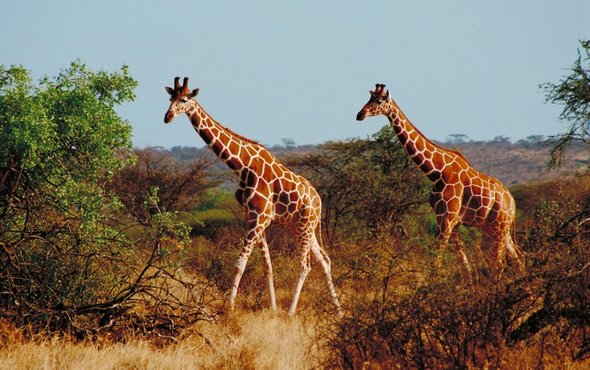(单词翻译:单击)
听力文本
This is Scientific American — 60-Second Science. I'm Jason G. Goldman.
Got a minue?
The giraffe is an icon of the African savannah. The lion is the top predator of the ecosystem. Both animals face uncertain futures, and both are subjects of intense, ongoing conservation work. Now a study suggests that saving one might mean bad news for the other.
"When I was out in the field, I heard anecdotes from people that in one of my study sites there were very few juvenile giraffes, because apparently the lions in the area had developed a preference for taking young giraffes."
University of Bristol biologist Zoe Muller. Working in Kenya's Great Rift Valley, she focused her attention on two neighboring sites: a national park with lots of lions, and a privately owned conservancy with no lions.
In the lion-free conservancy, 26 percent of the giraffes were less than one year old. But in the lion-filled park, juvenile giraffes made up only 5 percent of the species' population.
"So I was able to show really that actually in the presence of lions, the number of juveniles is severely reduced, by actually 83 percent. Which was a lot higher than I thought it would be. Quite shocking, actually."

Giraffe populations have declined by some 40 percent in the last 30 years, with fewer than 98,000 individuals left in the wild. In recognition of those figures, they've recently been classified as "vulnerable," that is, likely to become endangered.
The ongoing loss of juveniles could lead to a situation where the population crashes, since population growth and stability both rely on having enough calves survive to sexual maturity—so they, too, can breed and produce offspring of their own.
The study compares only two sites in East Africa. But it highlights the extreme complexity of wildlife management in Africa, where the recovery of one species could potentially come at the cost of another.
"Unfortunately, in East Africa especially, most of the conservation areas these days are fenced and enclosed. And so this is going to become an increasingly more common problem, where we find that predators are being enclosed in specific areas."
Allowing for the conservation of both species in the same areas is thus a tricky proposition. Muller says that one possibility might be to translocate giraffes into and out of lion-free areas, or to translocate lions into and out of places with lots of giraffes. If we do that, we may help ensure the two species' survival. But are they still truly wild?
Thanks for the minute for Scientific American — 60-Second Science. I'm Jason G. Goldman.
参考译文
这里是科学美国人——60秒科学。我是杰森·古德曼。
有一分钟时间吗?
长颈鹿是非洲大草原的象征。狮子是生态系统中的顶尖捕食者。这两种动物都面临着不确定的未来,二者都是目前紧张的保护工作的主要保护对象。现在一项研究表明,拯救其中一种动物可能不利于另外一种动物。
“我在野外工作时,在其中一个研究地点听当地人说该地的小长颈鹿数量非常少,因为狮子变得偏爱食用小长颈鹿了。”
布里斯托大学的生物学家佐伊·穆勒说。在肯尼亚的东非大裂谷工作时,她把注意力集中在两个相邻地点:有许多狮子的国家公园以及没有狮子的私人保护区。
在没有狮子的保护区里,26%的长颈鹿不到一岁。但是在到处都是狮子的国家公园里,小长颈鹿在族群的占比只有5%。
“所以我可以说,由于狮子的存在,小长颈鹿的数量急剧下降了83%。这个数字比我预想的要高出很多。这真的令人非常震惊。”
在过去30年中,长颈鹿的数量已经下降了约40%,目前野生长颈鹿的数量不足9.8万只。基于这些数字,他们最近将长颈鹿列为“易危物种”,即很可能濒临灭绝。
小长颈鹿持续减少可能导致种群数量暴跌,由于种群数量的增长和稳定性均依赖于足够多的幼崽生存至性成熟期——这样它们也能繁殖孕育自己的后代。
这项研究只比较了东非两个地点的情况。但是研究凸显了非洲野生动物管理的极端复杂性,在非洲,一个物种的恢复可能会以牺牲另一个物种为代价。
“最近大部分保护区都被围栏隔离并封闭起来,而不幸的是,这种情况在东非尤甚。因此,在捕食者被封闭在特定区域的地方,这将成为一个日益普遍的问题。”
在同一地区既保护狮子又保护长颈鹿是个棘手的问题。穆勒表示,其中一种可能的解决方法是,将长颈鹿移入或移出没有狮子的地区,或者将狮子移入或移出有大量长颈鹿的地区。如果我们采取这种做法,也许可以帮助两个物种生存下来。但它们还算真正的野生动物吗?
谢谢大家收听科学美国人——60秒科学。我是杰森·古德曼。
译文为可可英语翻译,未经授权请勿转载!
重点讲解
重点讲解:
1. make up 组成;构成;
Women make up 56% of the student numbers.
女生占学生人数的56%。
2. in recognition of 获官方认可;正式承认;
He had just received a doctorate in recognition of his contributions to seismology.
他刚被授予了博士头衔以表彰他对地震学作出的贡献。
3. lead to 招致;致使;导致;
There are recognised black spots in marriages which can lead to trouble.
婚姻中有一些公认的容易引发问题的雷区。
4. rely on 依赖;依靠;
As babies, we rely entirely on others for food.
在婴儿时期,我们完全依赖别人喂食。


